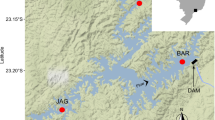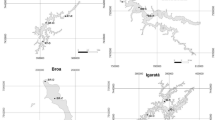Synopsis
The breadth, correspondence and overlap of the diets of the small and large size classes of the three native species (Galaxias occidentalis, Bostockia porosa and Edelia vittata) and two introduced species (Gambusia holbrooki and Perca fluviatilis) of fishes found in the shallows of the main channel and in the tributary creeks of a south-western Australian river have been compared in each season. Classification and ordination were used to examine the overall interrelationships of the diets across species, size groups, seasons and the location where the fish were caught (channel or creek). The smaller fish had a narrower dietary breadth than larger fish in the spring and summer, presumably reflecting the size limit imposed on prey size by their possession of a relatively small mouth in these seasons. Intraspecific dietary overlap between large and small size classes was usually high in G. occidentalis, but generally low in G. holbrooki and P. fluviatilis, and also in B. porosa and E. vittata when the difference between the lengths of the two size groups was greatest. Dietary overlap was least in autumn when the main prey taxa were most abundant. During winter, the diets of the three native species in the tributaries converged, probably reflecting a relatively low faunal diversity in these highly seasonal water bodies. The only relatively consistent interspecific overlap in diet was between B. porosa and E. vittata. Classification and ordination of the dietary samples separated G. occidentalis (which fed extensively on terrestrial organisms from the water surface) from the smaller P. fluviatilis (that concentrated on copepods in the plankton) and from B. porosa and E. vittata (which ingested primarily benthic organisms). Furthermore, B. porosa tended to ingest larger prey taxa than E. vittata. The diet of Gambusia holbrooki is sometimes dominated by terrestrial insects and at other times by benthic organisms, demonstrating that this species is an opportunistic carnivore. It is concluded that food partitioning by the three native and two introduced fish species in the Collie River is likely to be one of the principal factors facilitating the coexistence of substantial populations of these species in this system.
Similar content being viewed by others
References cited
Allen, G.R. 1982 A field guide to inland fishes of Western Australia Western Australian Museum Perth 86 pp.
Allen, G.R. 1989. Freshwater fishes of Australia. T.F.H. Publications, Neptune City. 280 pp.
Angermeier, P.L. 1982. Resource seasonality and fish diets in an Illinois stream. Env. Biol. Fish. 7: 251–264.
Anon. 1988. SPSS-XTTM users' guide. SPSS Inc., Chicago. 1072 pp.
Arthington, A.H. 1989. Diet of Gambusia affinis holbrooki, Xiphophorus helleri, X. maculatus and Poecilia reticulata (Pisces: Poeciliidae) in streams of southeastern Queensland, Australia. Asian Fisheries Science 2: 193–212.
Arthington, A.H. & L.N. Lloyd 1989 Introduced poecilids in Australia and New Zealand. pp. 333–347. In: G.K. Meffe & F.F. Snelson (ed.) Ecology and Evolution of Livebearing Fishes (Poeciliidae), Prentice Hall, Englewood Cliffs.
Ball, J.N. 1961. On the brown trout of Llyn Tegid. Proc. Zool. Soc. Lond. 137: 599–622.
Boikova, O.S. 1986. Feeding of fish in Lake Glubokoe. Hydrobiologia 141: 95–111.
Cadwallader, P.L. 1975. Feeding relationships of galaxiids, bullies, eels and trout in a New Zealand river. Aust. J. Mar. Freshwat. Res. 26: 299–316.
Coy, N.J. 1979. Freshwater fishing in south-West Australia. Jabiru Books, Perth. 216 pp.
Delbeek, J.C. & D.D. Williams. 1987. Food resource partitioning between sympatric populations of brackish water sticklebacks. J. Anim. Ecol. 56: 949–967.
Delbeek, J.C. & D.D. Williams. 1988. Feeding selectivity of four species of sympatric stickleback in brackish-water habitats in eastern Canada. J. Fish. Biol. 32: 41–62.
Gibson, R.N. & I.A. Ezzi. 1987. Feeding relationships of a demersal fish assemblage on the west coast of Scotland. J. Fish. Biol. 31: 55–69.
Gladfelter, W.B. & W.S. Johnson. 1983. Feeding niche separation in a guild of tropical reef fishes (Holocentridae). Ecology 64: 552–563.
Guma'a, S.A. 1978. The food and feeding habits of young perch, Perca fluviatilis, in Windermere. Freshwat. Biol. 8: 177–187.
Harmelin-Vivien, M.L., R.A. Kaim-Malka, M. Ledoyer & S.S. Jacob-Abraham. 1989. Food partitioning among scorpaenid fishes in Mediterranean seagrass beds. J. Fish. Biol. 34: 715–734.
Harrington, R.W. & E.S. Harrington. 1961. Food selection among fishes invading a high subtropical salt marsh: from onset of flooding through the progress of a mosquito brood. Ecology 42: 646–665.
Hill, M.O. 1979. TWINSPAN: A FORTRAN program for arranging multivariate data in an ordered two-way table by classification of the individuals and attributes. Cornell University, Ecology and Systematics Ithaca. 52 pp.
Holbrook, S.J., R.J. Schmitt & J.A. Coyer. 1985. Age related dietary patterns of sympatric adult surfperch. Copeia 1985: 986–994.
Hurlbert, S.H. & M.S. Mulla. 1981. Impacts of mosquito fish (Gambusia affinis) predation on plankton communities. Hydrobiologia 83: 125–151.
Hynes, H.B.N. 1950. The food of sticklebacks with a review of methods used in studies of the food of fishes. J. Anim. Ecol. 19: 36–58.
Hyslop, E.J. 1986. The food habits of four small-sized species of Mormyridae from the flood plain pools of the Sokoto-Rima river basin, Nigeria. J. Fish. Biol. 28: 147–151.
Keast, A. 1977. Diet overlaps and feeding relationships between the year classes in the yellow perch (Perca flavescens). Env. Biol. Fish. 2: 53–70.
Keast, A. 1978. Trophic and spatial interrelationships in the fish species of an Ontario temperate lake. Env. Biol. Fish. 3: 7–31.
Keast, A. 1985. Development of dietary specializations in a summer community of juvenile fishes. Env. Biol. Fish. 13: 211–224.
Keast, A. & M.G. Fox. 1990. Fish community structure, spatial distribution and feeding ecology in a beaver pond. Env. Biol. Fish. 27: 201–214.
Linton, L.R., R.W. Davies & F.J. Wrona. 1981. Resource utilization indices: an assessment. J. Anim. Ecol. 50: 283–292.
Martin, F.D. 1984. Diets of four sympatric species of Etheostoma (Pisces: Percidae) from southern Indiana: interspecific and intraspecific multiple comparisons. Env. Biol. Fish. 11: 113–120.
Meffe, G.K. 1985. Predation and species replacement in American southwestern fishes: a case study. Southwest. Nat. 30: 173–187.
Meffe, G.K., W.L. Hendrickson & W.L. Minckley. 1983. Factors resulting in decline of the endangered sonoran topminnow Poeciliopsis occidentalis (Atheriniformes: Poecillidae) in the United States. Biol. Conserv. 25: 135–159.
Mendelsson, J. 1975. Feeding relationships among species of Notropis (Pisces: Cyprinidae) in a Wisconsin stream. Ecol. Monogr. 45: 199–230.
Merrick, J.R. & G.E. Schmida. 1984. Australian freshwater fishes: biology and management. Griffin, Adelaide. 409 pp.
Morton, R.M., J.P. Beumer & B.R. Pollock. 1988. Fishes of a subtropical Australian saltmarsh and their predation upon mosquitoes. Env. Biol. Fish. 21: 185–194.
Motta, P.J. 1988. Functional morphology of the feeding apparatus of ten species of Pacific butterflyfishes (Perciformes, Chaetodontidae): an ecomorphological approach. Env. Biol. Fish. 22: 39–67.
Moyle, P.B. & F.R. Senanayake. 1984. Resource partitioning among the fishes of rainforest streams in Sri Lanka. J. Zool. (Lond.) 202: 195–223.
Paszkowski, C.A. 1985. The foraging behaviour of the central mud minnow and yellow perch: the influence of foraging site, intraspecific and interspecific competition. Oecologia 66: 271–279.
Pen, L.J. & I.C. Potter. 1990. The biology of the nightfish, Bostockia porosa, in a south-western Australian river. Aust. J. Mar. Freshwat. Res. 41: 627–645.
Pen, L.J. & I.C. Potter. 1991a. Biology of the western minnow, Galaxias occidentalis Ogilby (Teleostei: Galaxiidae) in an Australian river. 1. Reproductive biology. Hydrobiologia 211: 77–88.
Pen, L.J. & I.CC. Potter. 1991b. Biology of the western minnow, Galaxias occidentalis Ogilby (Teleostei: Galaxiidae), in an Australian river. 2. Size composition, age structure, growth rates and diet. Hydrobiologia 211: 89–100.
Pen, L.J. & I.C. Potter. 1991c. The biology of the western pygmy perch, Edelia vittata, and comparisons with two other teleost species endemic to south-western Australia. Env. Biol. Fish. 31: 365–380.
Pen, L.J. & I.C. Potter. 1991d. Reproduction, growth and diet of Gambusia holbrooki Girard in a temperate Australian river. Aquat. Conserv. 1: 159–172.
Persson, L. 1983. Effects of intra- and interspecific competition on dynamics and size structure of a perch Perca fluviatilis and roach Rutilus rutilus population. Oikos 41: 126–132.
Persson, L. 1986. Effects of reduced interspecific competition on resource utilization in perch (Perca fluviatilis). Ecology 67: 355–364.
Persson, L. 1987a. Effects of habitat and season on competitive interactions between roach (Rutilus rutilus) and perch (Perca fluviatilis). Oecologia 73: 170–177.
Persson, L. 1987b. Competition-induced switch in young of the year perch, Perca fluviatilis: an experimental test of resource limitation. Env. Biol. Fish. 19: 235–239.
Persson, L. 1987c. The effects of resource availability and distribution on size class interactions in perch, Perca fluviatilis. Oikos 48: 148–160.
Pianka, E.R. 1973. The structure of lizard communities. Annu. Rev. Ecol. Syst. 4: 53–74.
Pianka, E.R. 1986. Ecology and natural history of desert lizards. Princeton University Press, New Jersey. 208 pp.
Pielou, E.C. 1966. The measurement of diversity in different types of biological collections. J. Theor. Biol. 13: 131–144.
Popova, O.A. & L.A. Sytina. 1977. Food and feeding relations of Eurasian perch (Perca fluviatilis) and pikeperch (Stizostedion lucioperca) in various waters of the USSR. J. Fish. Res. Board. Can. 34: 1559–1570.
Prince, J.D., I.C. Potter, R.C.J. Lenanton & N.R. Loneragan. 1982. Segregation and feeding of atherinid species (Teleostei) in south-western Australian estuaries. Aust. J. mar. Freshwat. Res. 33: 865–880.
Rask, M. 1983. Differences in growth of perch (Perca fluviatilis L.) in two small forest lakes. Hydrobiologia 101: 139–144.
Robertson, A.I. 1980. The structure and organisation of an eelgrass fish fauna. Oecologia 47: 76–82.
Ross, S.T. 1986. Resource partitioning in fish assemblages: a review of field studies. Copeia 1986: 352–388.
Ross, S.T. 1991. Mechanisms structuring stream fish assemblages: are there lessons from introduced species? Env. Biol. Fish. 30: 359–368.
Schoener, T.W. 1970. Non-synchronous spatial overlap of lizards in patchy habitats. Ecology 51: 408–418.
Scroener, T.W. 1974. Resource partitioning in ecological communities. Science 185: 27–29.
Scrimgeour, G.J. & M.J. Winterbourn. 1987. Diet, food resource partitioning and feeding periodicity of two riffle-dwelling fish species in a New Zealand river. J. Fish. Biol. 31: 309–324.
Spanovsky, V.D. & V.A. Grygorash. 1977. Development and food of age-0 Eurasian perch (Perca fluviatilis) in reservoir nears Moscow, USSR. J. Fish. Res. Board. Can. 34: 1551–1558.
Steel, R.G.D. & J.H. Torrie. 1980. Principles and procedures of statistics: a biometrical approach. 2nd edit. McGraw-Hill, Sydney. 633 pp.
Tallman, R.F. & J.H. Gee. 1982. Intraspecific resource partitioning in a headwaters stream fish, the pearl dace Semotilus margarita (Cyprinidae). Env. Biol. Fish. 7: 243–249.
Wallace, R.K. 1981. An assessment of diet-overlap indexes. Trans. Amer. Fish. Soc. 110: 72–76.
Welton, J.S., C.A. Mills & E.L. Rendle. 1983. Food and habitat partitioning in two small benthic fishes, Noemachedus barbatulus (L.) and Cottus gobio L. Arch. Hydrobiol. 97: 434–454.
Williams, W.T. 1971. Principles of clustering. Annu. Rev. Ecol. Syst. 2: 303: 326.
Winemiller, K.O. 1989. Ontogenetic diet shifts and resource partitioning among piscivorous fishes in the Venezuelen ilanos. Env. Biol. Fish. 26: 177–199.
Zaret, T.M. & A.S. Rand. 1971. Competition in tropical stream fishes: support for the competition exclusion principle. Ecology 51: 336–342.
Author information
Authors and Affiliations
Rights and permissions
About this article
Cite this article
Pen, L.J., Potter, I.C. & Calver, M.C. Comparisons of the food niches of three native and two introduced fish species in an Australian river. Environ Biol Fish 36, 167–182 (1993). https://doi.org/10.1007/BF00002797
Received:
Accepted:
Issue Date:
DOI: https://doi.org/10.1007/BF00002797




